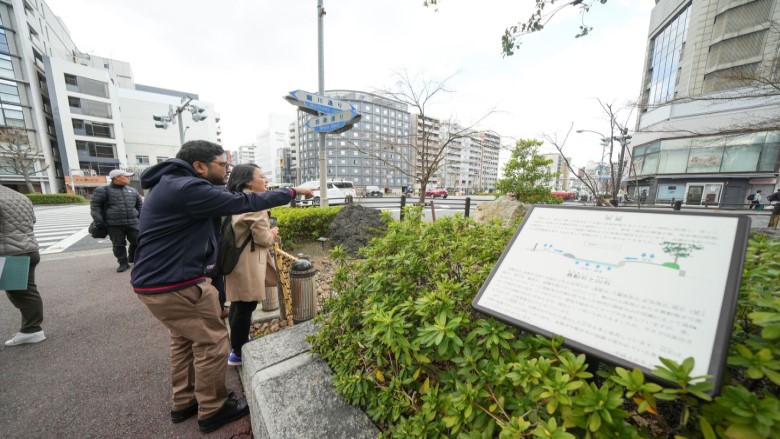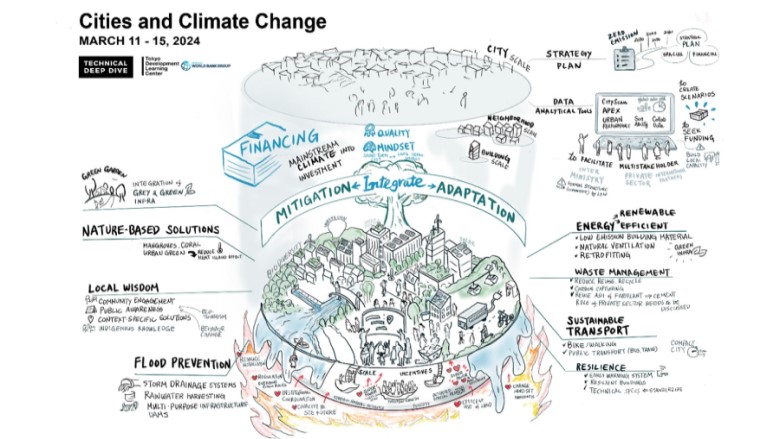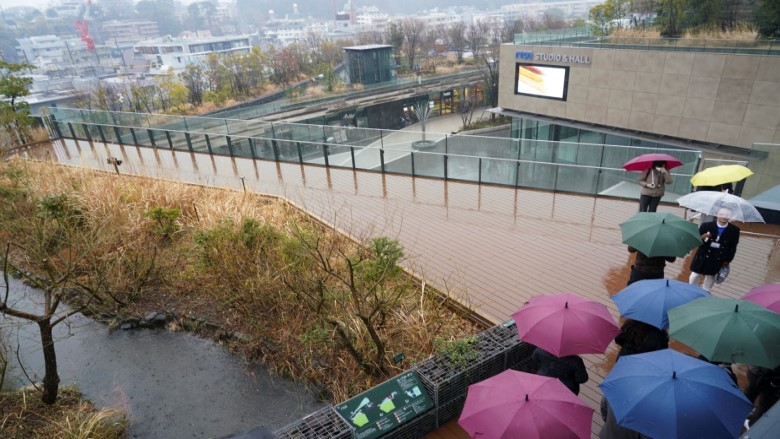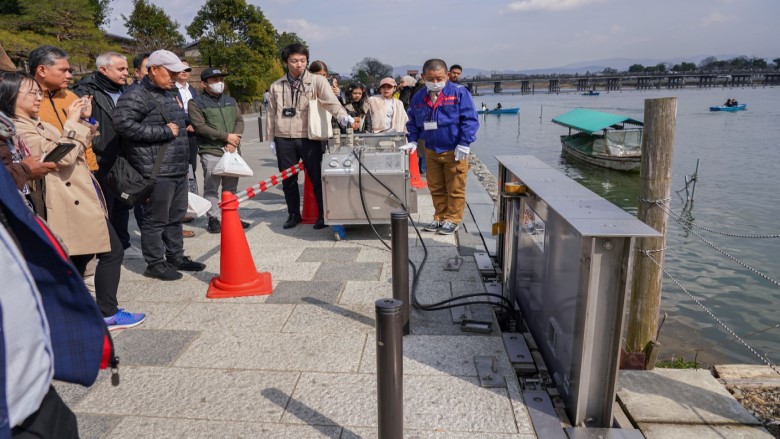
March 11 -15, 2024 Tokyo and Kyoto, Japan
Context
Cities play a crucial role in addressing climate change, as around 70% of greenhouse gas emissions originate from urban activities. Without mitigation efforts, emissions in cities could double by 2050. But aggressive and immediate actions could reduce them to nearly net zero. Additionally, cities need to adapt to the impacts of climate change, as they are already disproportionately affected by coastal flooding, extreme heat, and other hazards that are worsened by climate change. With urban populations expected to continue rising, especially in highly vulnerable regions such as South Asia and Africa, cities must enhance their resilience to adapt to these changes.
The objective of this TDD is to provide an opportunity for World Bank client country delegations to get a deeper understanding of good practices in urban climate adaptation and mitigation. The TDD focused on topics such as planning and analysis for climate mitigation and adaptation, grey and green solutions at the neighborhood and building levels. Examples of flood damage control measures were also presented, the choice of which were based on the needs of the participants. The presentations and site visits emphasized cross-sectoral approach, social inclusion and participation in addressing climate change. Eight (8) country teams came together in Tokyo and Kyoto to learn about climate change mitigation and adaptation measures at the city, neighborhood, and building levels.
Client Challenges
Participants raised various challenges in creating cities that respond to climate change. Many pointed to the following challenges: (1) investing in climate change-adaptive infrastructure within stringent city budgets, (2) changing the mindset of the private sector and citizens to implement climate change policies, and (3) overlapping authority and lack of norms and standards that inhibit effective governance and planning for climate adaptation. Clients pointed out the importance of multi-sector collaboration in achieving comprehensive solutions.

Key findings
The TDD generated valuable insights from both participants and experts on climate change response. The following are some key takeaways from the TDD:
- Climate change action planning should be evidence-based, inclusive, and multisectoral, considering strategy, spatial approaches, and financing needs. Analytical tools such as Urban Performance, SuitAbility, and APEX can help cities and their stakeholders identify priority areas for action and investment. The emphasis, however, should not solely be on data analysis but on using data to understand each stakeholder's perspective and facilitate dialogue among different parties.
- Nature-based Solutions (NbS), such as green roofs and rain gardens, can help cities effectively reduce urban heat and flooding. They can be implemented at different scales and are often cost-effective when combined with grey infrastructure. In order to effectively utilize nature-based solutions (NbS), it is crucial to thoroughly consider the needs of the local community and the surrounding environment. It is also important to predict in advance the specific benefits that each type of NbS can bring to the area.
- Achieving low-carbon goals necessitates voluntary and proactive engagement from all citizens. This involves establishing new institutions, fostering innovation and facilitating the dissemination of actionable information. By conducting social experiments, even on a small scale, and involving the private sector and citizens, cities can raise awareness of climate change and encourage citizens to take action.
- New buildings can achieve resilience and sustainability through actions taken before and during construction. Existing buildings can also become resilient and sustainable through effective operation and maintenance, as well as cost evaluation for retrofitting. Building codes should include low-carbon principles and incorporate indicators for green and resilient housing.
TDD Site Visits
Futako-Tamagawa is a quiet residential area 10 minutes away by train from downtown Tokyo. The area is a dense residential area but also hosts commercial buildings, offices and parks especially around the Futako-Tamagawa Station. This visit offered participants lessons on transit-oriented development, urban greening and waterfront space (creation efforts by the private sector and local government), and urban flood control efforts.

Kyoto City Downtown Participants strolled around Kyoto City downtown using public transportation or by walking to observe and learn about nature-based solutions, such as rain gardens and rooftop greening. They saw the Kyoto Gyoen Park and the Shijo Horikawa Intersection. They also visited the Sugimoto Residence, a sustainable Kyoto-style wooden townhouse (machiya) that leverages natural lighting, rainwater, and natural breeze in living spaces. In addition, they visited JR Kyoto Station to gain a deeper understanding of green initiatives in large buildings.
Arashiyama - Participants visited Arashiyama to observe a retractable watertight wall along the Katsura River and a 'bamboo grove path' known for its carbon dioxide absorption and landscape preservation after sessions. During the visit, participants discussed with Kyoto city officials about flood prevention measures along the Katsura River, such as upstream dams, coordination of early warning systems, collaboration among the national government, Kyoto Prefecture, and Kyoto City, as well as the associated costs and benefits of such investments.

Next Steps
Through the five-day TDD, participants were reminded that climate change action and urban development are interrelated, and that integrated planning, regulation, and incentives are essential for effective climate change action. They also realized the need to transcend interdepartmental boundaries and promote public-private partnerships and citizen participation, which requires multi-sectoral capacity building.
Many participants expressed plans to implement nature-based solutions such as rain gardens as well as climate change policies, regulations, and pilot programs to engage politicians and other stakeholders in pushing for more sustainable and inclusive urban development.
Participant Feedback
A survey was conducted immediately after the TDD. With a response rate of 74%, 100% of participants expressed satisfaction with the TDD program, with 92% indicating they were "Very Satisfied" and 8% reporting they were "Satisfied." All participants believed that the TDD helped them understand solutions relevant to their respective programs or projects.
Many participants appreciated the presentations including on NbS (e.g., rain gardens) and Transit-Oriented Development (TOD) concept implemented at stations to enhance ridership and efficiency. They expressed satisfaction with the “thoughtful arrangements made by event facilitators”. The visits to Kyoto also left a good impression on participants, with many expressing admiration for the city's climate change strategies that feature a harmonious blend of tradition and modernity.
On the other hand, participants offered suggestions for improving future TDDs, including streamlining presentations to focus on key issues and main takeaways, extending the program duration to allow for deeper engagement and learning, additional sessions for practitioners in Japan and other countries to provide examples of urban development models.
Voices from Participants
“We are very ambitious after the meeting, after engaging in four to five days of discussions. Now, we are considering how to pilot some of these concepts within our reality, while also adapting them to our current situation in terms of knowledge and skills.”
(Hélio Banze, Permanent Secretary, Ministry of Public Works, Housing and Water Resources, Mozambique)
“I found the case studies and site visits to be highly informative, as they were backed by thorough knowledge, comprehensive information, and refined data. The way they linked a case study to the presentation and followed up with a site visit to demonstrate real-time value was very effective in shaping our understanding.”
(Hasan Akçay, Senior Mechanical Engineer, Istanbul Project Coordination Unit, Turkey)